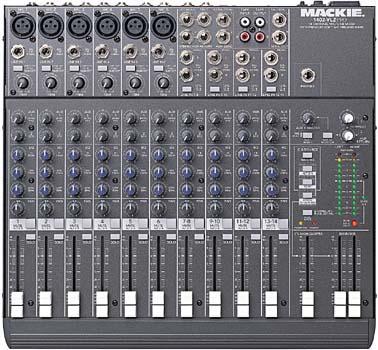Mixing
Here is a simple professional mixer. It has six preamped inputs, and 4 non-amped stereo inputs.

All mixer images from Mackie.com
The signal from a microphone is then sent to a mixer. Most mixers have built in pre-amps which take the really small electrical signal created from the microphone and amplify it to a voltage that most professional effects or amps could use

This is the input/out section of a mixer. The six preamps have a trim (gain) which controls the sensitivity of the microphones. If the trim is set too high with a highly sensitive microphone, distortion is a result which creates an undesirable tone. The non-amped channels (7-14) are stereo so that inputs from a computer source ( MIDI) such as keyboards, electronic drums, turntables, etc. The low cut on channels 1-6 is designed for eliminating low frequency (bass) rumble from the microphone. The reason that the inputs have balanced or unbalanced printed, is that any phase of input could be used (i.e., if a microphone or line input hot and neutral wires are wired backwards, also eliminates hum in some cases). The AUX send/return is designed for effects or monitors. This particular mixer has a tape input and output so that music could be played during breaks and so that a digital/analog recorder could be used.
 |
This is a channel strip of a mixer. The AUX 1 is used for monitor/effects as said above. Having a monitor is necessary for a singer; it is really difficult to sing in the right key of the song with out a source of monitor. The second AUX is used for effects such as a delay, or reverb. The EQ (equalizer) section highly used. The High EQ knob adjusts the high frequency of the unit. A human ear could hear within a top range of about 18 KHz to 20 KHz. The mid frequency boosts all the sounds within the human hearing threshold, when the mid frequency is lowered past the unity (U at 12:00) point; a "scooped" sound is created. It sounds nicer to have a "scooped" sound, but does not do much to be heard on stage competing with a bass guitar/drum and cymbals/high hat on drums. Having a mid frequency set high is critical to "cut" through the mix. The bass section boosts all the frequencies that a human could hear. Most people have a low end hearing threshold of 30-40 Hz. A bass drum usually uses the low frequencies past 80 Hz. A bass guitar used frequencies from 50-60 Hz to the higher mid frequencies around 4 KHz. Vocals use most of the frequency spectrum, and guitars, use the midrange spectrum. The pan knob adjusts the signal to the left or right speaker. The fader adjusts the overall volume to the main mix. The solo button is used to adjust the trim to get a proper signal without clipping. |

Here is the back end of the mixer. There is the power switch, and the phantom power switch. I bet you’re wondering, "What is phantom power?" It is a 48V to a microphone that needs it. But why should a microphone need 48 volts? Not all microphones are dynamic (no need for external power), some condenser microphones need a phantom power supply to work. Condenser microphones are primarily used for recording, but there are condenser microphones that are great for live use. An AKG C1000S (below) is a condenser microphone great for drum cymbals
(image from Musiciansfriend.com) |
The main outputs are in stereo, which is balanced, so that no phase cancellations could occur, phase cancellation is how one signal would be negative, and the other is positive, which will cancel out the overall sound and lose great volume in sound reinforcement. The Control room outputs are pretty much the same as an AUX out, but could be used in a control room, such as broadcast recording. The alt output is just another output for any use. The channel inserts could be used for individual effects for each channel such as a compressor which helps control dynamics of an input to eliminate distortion. |
< Introduction | Mics | Mixers | Effects | Poweramps | Speakers | Works Cited >
